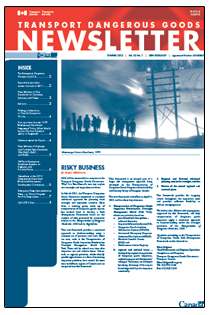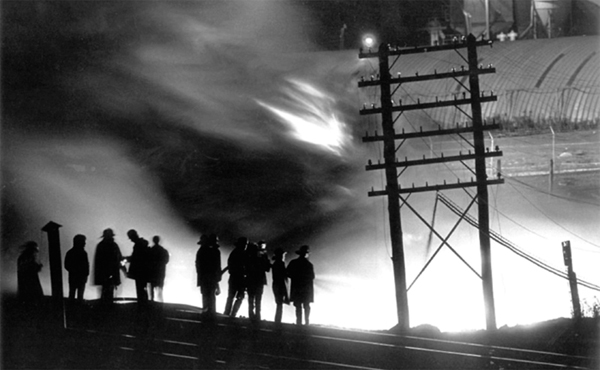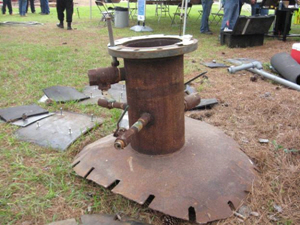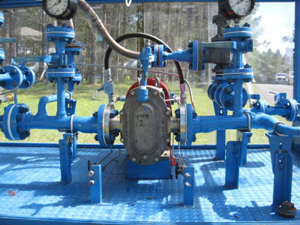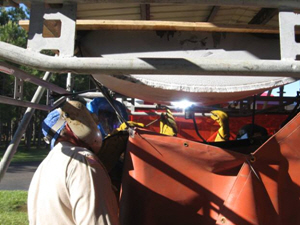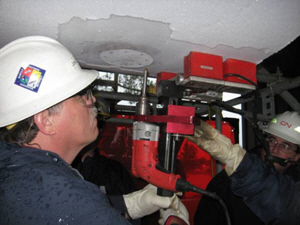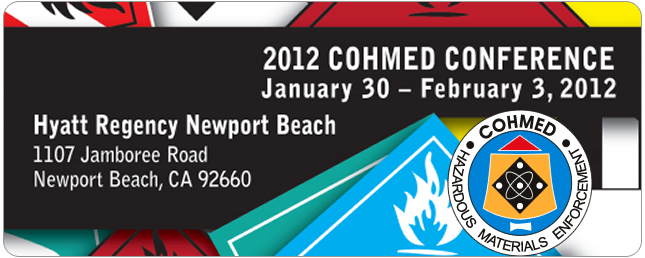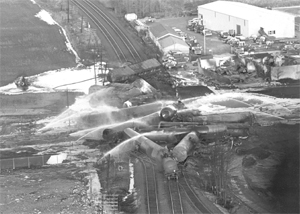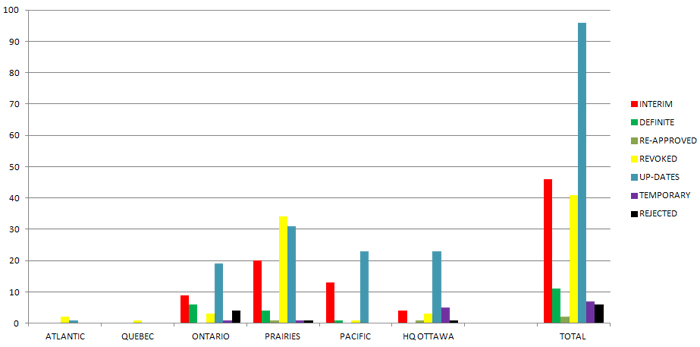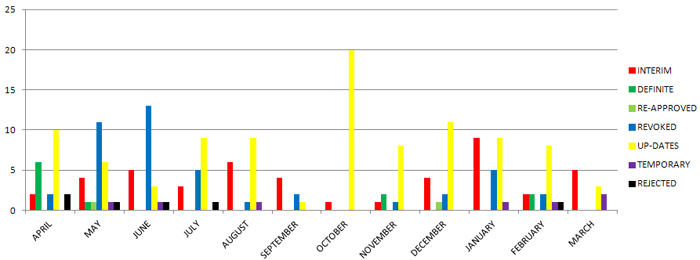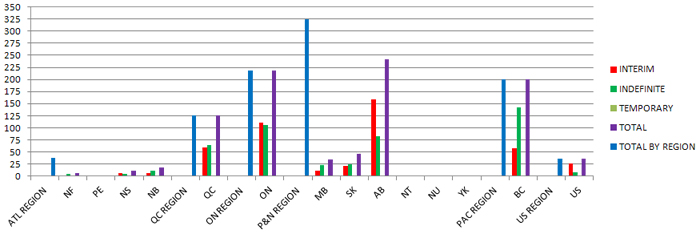Summer 2012 | Vol. 32 No. 1 | ISSN 0828-5039 | Agreement Number 40063845
Inside
-
New Editions of CSA Standards for Cylinders, Spheres, and Tubes
-
New Editions of Highway and Portable Tank Standards CSA B620, B621, and B622
-
Off-Truck Emergency Shutdown Systems on Highway and Portable Tanks
-
Canadians at the 2012 Cooperative Hazardous Materials Enforcement Development Conference
-
Emergency Response Assistance Plans – A Critical Program For First Responders
Image: Mississauga Ontario Derailment, 1979
Risky Business
By Marc Grignon
2012 will be memorable to everyone at the Transport Dangerous Goods Directorate. Why? It is Year One of a new way to plan our oversight and inspection activities.
In March 2011, the Transport Dangerous Goods Directorate committed to a national risk-based approach for planning their oversight and inspection activities. Since then, a working group made up of transportation of dangerous goods experts has worked hard to develop a Risk Management Framework based on the analysis of risks presented by companies subject to the Transportation of Dangerous Goods Act, 1992 and its Regulations.
This new framework provides a structured approach to decision-making using a common set of processes and tools. Some are new, such as the Transportation of Dangerous Goods Inspection Prioritization Oversight Management Model Risk Tool. These will be refined over time after inspectors test and evaluate them. Others, such as regional priorities, which identify specific regional issues as a factor determining inspection priorities, have existed for some time in different regions of Canada and are integrated into this framework.
This framework is an integral part of a larger risk management approach being developed in the Transportation of Dangerous Goods Program and in the Safety and Security Group of Transport Canada.
The new framework took effect on April 1st, 2012 and has three key elements:
- Transportation of Dangerous Goods Inspection Prioritization Oversight Management Model (Risk Tool), which sets priorities based on:
- pre-determined data points – collected from the:
- Inspector Information System (IIS);
- Dangerous Goods Accident Information System (DGAIS);
- Automated Emergency Response Assistance Plan database (AERAP);
- Statistics Canada's Census (2006); and
- Enforcement Action Registry.
- regional and national issues – developed by regional transportation of dangerous goods inspectors, regional managers and Headquarters' managers. These issues are developed by taking advantage of the expert knowledge held by the inspector community.
- pre-determined data points – collected from the:
- Regional and National risk-based planning exercise for oversight activities
- Review of the annual regional and national plans
The framework provides for on-going review throughout the inspection cycle and provides sufficient flexibility to address emerging issues.
We believe that effective risk management, supported by this framework, will help transportation of dangerous goods inspectors apply a consistent approach to decision-making under the oversight provisions of the Transportation of Dangerous Goods Act, 1992.
Questions pertaining to the Transportation of Dangerous Goods Risk Management Framework can be directed to:
Marc Grignon
Chief, Enforcement and Response Operations
Compliance and Response
Transport Dangerous Goods Directorate
Transport Canada
Marc.Grignon@tc.gc.ca
Tel: 613-990-1146
Fax: 613-952-1340
THE EMERGENCY RESPONSE GUIDEBOOK 2012
by Michel Cloutier
The Emergency Response Guide (ERG) is developed jointly by Transport Canada, the United States Department of Transportation, the Secretariat of Transport and Communications of Mexico with the collaboration of Centro de Información Química para Emergencias of Argentina (CIQUIME). Under the North American Free Trade Agreement, the ERG is published in English, French and Spanish.
The ERG helps first responders quickly identify specific or generic hazards of the material(s) involved in the incident. It also helps them protect themselves and the general public during the initial response phase. The Guidebook should be in each fire, police and ambulance (emergency response) vehicle to promote public safety and harmonize dangerous goods response guidance.
The 2012 edition of the ERG includes these new features:
- a Boiling Liquid Expanding Vapour Explosion (BLEVE) safety distances chart;
- an Improvised Explosive Device (IED) safe standoff distances chart; and
- Table 3 for six common Toxic Inhalation Hazard (TIH) gases that provides quantity-specific isolation and protective action distances.
For this new edition, many sections have been revised and updated. Among them are new material names to reflect the 17th edition of the United Nations Recommendations on the Transport of Dangerous Goods.
In Canada, Transport Canada printed 115,000 copies of the ERG 2012 for its provincial/territorial coordinators to distribute throughout the country. Visit CANUTEC at: http://www.tc.gc.ca/eng/canutec/guide-menu-227.htm to:
- find a complete list of distributors;
- access the online version of the ERG 2012; or
- download a database version of ERGO 2012.
In the United States, the Department of Transportation printed 2,000,000 copies of the ERG 2012 that State Agency representatives will distribute throughout the country. Visit http://hazmat.dot.gov/pubs/erg/gydebook.htm for a complete list of representatives. Commercial printers are expected to publish more than 6,000,000 copies of the Guidebook for sale to the trucking and rail industries as well as other transportation organizations.
In Latin America, nearly 50,000 copies of the Spanish version were printed and distributed to sixteen countries with help from CIQUIME and the Office of U.S. Foreign Disaster Assistance. To learn more about CIQUIME, please visit http://www.ciquime.org.ar/index.html.
The Emergency Response Guide is translated in other languages, as well, and is used in several countries around the world. Some of those languages are: Hungarian, Dutch, German, Hebrew, Japanese, Russian, Italian, Polish, Korean, Chinese, Turkish, Portuguese and Thai.
Reportable Accidents across Canada in 2011
By Susan Williams, Lindsay Jones and Jonathan Rose
A reportable accident involves a release of dangerous goods exceeding the quantity determined in Part 8 of the Transportation of Dangerous Goods Regulations.
This article presents statistics as well as sample accidents from 2011.
2011 Highlights*:
- 345 reportable accidents in Canada
- Top five dangerous goods products involved in reportable accidents
| Top five dangerous goods products involved in reportable accidents | Percentage |
|---|---|
| Petroleum Crude Oil - Class 3 | 27.2% |
| Diesel Fuel; Fuel Oil; Gas Oil; or Heating Oil Light - Class 3 | 12.7% |
| Methanol - Class 3 (6.1) | 7.8% |
| Hydrochloric Acid - Class 8 | 5.8% |
| Liquefied Petroleum Gases ; or Petroleum Gases, Liquefied - Class 2.1 | 4.9% |
- 62.9% occurred in Alberta
- 62.0% occurred during handling operations
- 94.5% were minor
- Accident severity is based on 10 true or false questions. We assign one point for each positive response. The point total represents the severity level:
- 0 to 3 is minor;
- 4 to 6 is moderate; and
- 7 to 10 is major.
- Accident severity is based on 10 true or false questions. We assign one point for each positive response. The point total represents the severity level:
* Data as of February 23, 2012.
A 30-Day Follow-Up Report must be submitted within 30 days of an accidental release, "dangerous goods accident" or "dangerous goods incident". Send these completed reports to Transport Canada either by e-mail, fax or mail.
- E-mail: dor-rcd@tc.gc.ca or rcd-dor@tc.gc.ca
- Fax: 613-991-2917
- Mail: Transport Dangerous Goods Directorate
Place de Ville, Tower C, 9th Floor
330 Sparks Street
Ottawa, Ontario K1A 0N5
Samples of 2011 reportable accidents
These sample accidents are taken from various provinces/territories, classes of dangerous goods, modes of transport and means of containment.
January 2, 2011
Fort St. John, British Columbia
Severity Level 2
Methanol - Class 3(6.1)
Means of Containment: Drum (UN1A2/Y/1.2/100/N CAN/GWC E/2 1053/11/12/300/09)
An oilfield truck carrying a 205-litre drum of METHANOL was driving down a hill when it went off the road, into a ditch and overturned. The drum was damaged and 90 litres of product was released. Emergency response personnel came on site to clean up the spill, upright the truck and remove it from the ditch.
This release was reportable because it was over the amount set in the table in subsection 8.1(1) for METHANOL's subsidiary class (Class 6.1 – 5-litre threshold), but not the primary class (Class 3 – 200-litre threshold).
March 13, 2011
Bernic Lake, Manitoba
Severity Level 2
Formic Acid - Class 8
Means of Containment: Tank Trailer (DOT407SS/Polar/2000/1PMS34322Y1022426/7000 USG/Tractor Trailer)
As the transfer of FORMIC ACID from a tank trailer into a mine site storage tank began, 36 kilograms of product was released from a loose connection between the tank trailer valve and the transfer hose. The spilled product went into a concrete containment pad and was immediately neutralized and cleaned up.
March 27, 2011
Port Hope, Ontario
Severity Level 7
Fuel, Aviation, Turbine Engine - Class 3
Liquefied Petroleum Gases; or Petroleum Gases, Liquefied - Class 2.1
Means of Containment: Tank Cars (DOT111A100 W1 and DOT1112J340 W)
Twenty-seven tank railcars derailed during transport on a main line. Eight of these contained AVIATION FUEL, and some overturned. Three of these were breached and approximately 125,000 litres of product was released. Another residue tank car containing BUTANE was also breached and most of its remaining product leaked, caught fire and burned itself out. Emergency response personnel came on site and evacuated 33 residents from nearby homes until the fire was extinguished. The spill was cleaned up and remaining product transfers were completed.
March 31, 2011
McBride, British Columbia
Severity Level 6
Liquefied Petroleum Gases; or Petroleum Gases, Liquefied - Class 2.1
Means of Containment: Tractor Tank Trailer (MC331LPG/Altank Industries/F4802 14342/02-1998/2A9LT3936JCC12221/3974L/10500USWG/05-10 VK 028/Super B Lead Trailer) and (MC331LPG/Altank Industries/F4802-14342/02-1988/2A9TL3226JCC12222/39747L/10500 USWG/05-10 VK 028/Super B Pup Trailer)
During transport, a tractor tank trailer and pup (B-Train) containing BUTANE overturned, slid off the highway down an embankment and came to rest 91 meters into the forest. The cargo in the lead trailer exploded and completely burned. A valve on the pup was damaged and slowly leaked product that burned for many days until emergency response personnel could perform a vent and burn operation to remove the residue. The driver was taken to the hospital with major injuries.
May 18, 2011
Saint Jacques, New Brunswick
Severity Level 2
Nitrogen, Refrigerated Liquid - Class 2.2
Means of Containment: Tractor Tank Trailer (CGA341/Lox Equipment Company/CRN 3-6703-5-2/05-1978/262 kPa/7818/27400L/03-05 VIP 034/06-10 V 285/Semi-trailer)
A tractor tank trailer containing NITROGEN, REFRIGERATED LIQUID was detained at a weigh scale after a leak was discovered. Product was leaking through the cap on the tank's filling connection into the atmosphere. A replacement cap was delivered to the weigh scale and successfully installed. The unit was then released to continue on to its destination.
June 11, 2011
Roddickton, Newfoundland and Labrador
Severity Level 4
Gasoline; Motor Spirit; or Petrol - Class 3
Means of Containment: Tractor Compartmentalized Tank Trailer (TC406AL/Remtec/TC-406/03-2003/24 kPa/C9-03/15000-4000-5000-5000-7000-14000L/05-11 VK 119/05-08 IPU/C /Main trailer)
A tractor compartmentalized tank trailer containing GASOLINE and DIESEL FUEL swerved to avoid an oncoming vehicle, went off the road and overturned. One compartment was punctured and 2,500 litres of GASOLINE was released. The driver was taken to the hospital with minor injuries. Emergency response personnel came on site to contain and clean up the spill and to transfer the remaining product into another tank trailer. The overturned unit was righted and removed from the accident scene.
June 23, 2011
Anzac, Alberta
Severity Level 2
Molten Sulfur; Molten Sulphur; Sulfur, Molten; or Sulphur, Molten - Class 4.1
Means of Containment: Tank Cars (DOT111A100 W3)
During rail transport in a remote forest area, seven tank cars containing MOLTEN SULPHUR derailed, four of which ended up on their sides. One was punctured and released 89,291 kilograms of product. The product ignited and started a small forest fire. Water bombers extinguished the fire, and emergency response personnel extinguished the product in the burning tank car using sand. The spilled product was cleaned up and, along with the contaminated soil, was removed from the site. The remaining tank cars were then righted and re-railed.
July 8, 2011
Edam, Saskatchewan
Severity Level 3
Ammonia, Anhydrous; or Anhydrous Ammonia - Class 2.3(8)
Means of Containment: Nurse Tank (Western Rock Bit/E 8016.234/1996/31976A/2000 USWG/09-09 PV 466/Single 2000)
A total of 820 litres of ANHYDROUS AMMONIA leaked from the withdrawal valve of a nurse tank sitting in a farm field. The shipper's emergency response personnel were on site and applied a freeze patch to stop the leak. The remaining liquid was transferred into a tank truck and the residual vapour was injected into a 1,135 litre water reservoir to dissipate the vapours. This practice is safer than flaring and produces a liquid fertilizer, which based on approved concentration levels, may be reapplied to hay fields. The empty nurse tank was then removed from the field.
August 19, 2011
Montréal, Quebec
Severity Level 3
Selenium Compound, N.O.S. - Class 6.1
Means of Containment: Drums (UN1A2)
There were 57 plastic-lined drums containing SELENIUM COMPOUND SOLID, N.O.S. being loaded into a tractor trailer at an airport. The product had been packaged as a moist cake. Nine were leaking a small amount of liquid, because a chemical reaction between the product and the drums' material had caused them to deteriorate. Emergency response personnel were on site to clean up the spilled product. The drums were placed into over-pack containers and removed from the site.
October 9, 2011
Mackenzie Highway, Northwest Territories
Severity Level 2
Solids containing Flammable Liquid, N.O.S. - Class 4.1
Means of Containment: Lined-box Dump Truck
While transporting SOLIDS CONTAINING FLAMMABLE LIQUIDS, N.O.S. in a lined-box dump truck, 200 kilograms of product was released along a 38 kilometre stretch of highway from an unsecured tailgate. The carrier's emergency response personnel shovelled up the product along the highway.
New Editions of CSA Standards for Cylinders, Spheres, and Tubes
by Pascal Verville
Compliance to the Canadian Standards Association (CSA) B339 and B340 standards in the selection, use, and manufacture of containers for dangerous goods in Class 2, Gases, is a requirement of Section 5.10 of the Transportation of Dangerous Goods Regulations.
-
The CSA B339 standard sets out the requirements for the design, manufacture, inspection, testing, marking, and periodic requalification of gas containers.
-
The CSA B340 standard sets out which gas container to use for the gas being transported.
While the 2002 edition of these standards, as amended, remain legally in force, the fifth, and revised edition of each, were published in March 2008. These will be proposed for adoption in a forthcoming amendment to the Transportation of Dangerous Goods Regulations.
Changes in the 5th edition of the CSA B339 standard include:
-
revised and new definitions of terms used in steel making;
-
permission to use container marking methods other than stamping — such as laser etching, embossing, or engraving — to account for new technologies in manufacturing processes;
-
revised requirements for the TC-4LM specification to account for the particular characteristics of cylinders in refrigerated helium service; and
-
a new cylinder specification designated as TC-3CCM for fully-wrapped composite cylinders with carbon fiber filament windings. Industry has been allowed to manufacture, select, and use such cylinders in Canada since 1999 under Permits for Equivalent Level of Safety, now known as Equivalency Certificates.
Changes in the 5th edition of the CSA B340 standard include:
-
revised requirements for valve protection;
-
permission to use TC-3CCM, TC-3FCM, and TC-3HWM containers for transport of hydrogen;
-
revised requirements in clause 5.5.4 of CSA B340-08 for non-specification vacuum-insulated containers for transport of certain refrigerated liquefied gases in Class 2.2. More specifically it imposes a 50 L water capacity limit for such containers. These containers must be closed and designed so as not to release their contents during transport. This means that:
-
open cryogenic containers commonly known as "Dewars" with no positive closure, and that continuously vent into the atmosphere, do not satisfy this requirement.
-
lids or cork stoppers that are loosely fitted to prevent air or moisture from entering the container and to allow for built-up pressure to escape are not adequate for transportation purposes; and
-
-
revised provisions for salvage containers incorporating the conditions of Special Permits issued by the Unites States Department of Transportation's Pipeline and Hazardous Materials Administration. These containers are used for overpacking leaking or damaged cylinders for transportation to the nearest facility for remediation. These are also known as emergency response containment vessels (ERCVs).
You can request copies of the revised standards in both official languages by contacting CSA at 1-800-463-6727 or by visiting their website at http://www.csa.ca.
Editorial
The "circle of life" at the Transport Dangerous Goods Directorate is likely very similar to that of many other programs. The broad outline of ours looks a little like this: the research, statistics and risk evaluation developed by the Research, Evaluation and Systems branch helps the Regulatory Affairs branch to steer its work on legislative, regulatory and political initiatives adopted to promote the safe and secure transportation of dangerous goods within Canada. In turn, the Compliance and Response branch ensures that the law and regulations are observed and they communicate the results of their interventions, and any trends and risk they observe during enforcement activities, to the Research, Evaluation and Systems branch. This information then helps collect important data that will be used to create regulatory projects and so on.
Why am I bringing this up? Because we have recently adopted measures intended to improve monitoring, inspection and risk evaluation activities, which will have a positive impact on the entire program. The article on the cover page details this new initiative. In fact, all the articles presented in this edition of the Newsletter provide a glimpse of the spokes on the wheel that we are all helping to move forward.
Happy reading!
Finding a Laboratory to Classify Dangerous Goods
by Julie Prescott
Section 2.2 of the Transportation of Dangerous Goods Regulations holds consignors of dangerous goods responsible for the correct classification of the substances they ship. To help them do this, the Transport Dangerous Goods Directorate keeps a list of laboratories that provide analysis and classification services. You can find it online at http://www.tc.gc.ca/eng/tdg/contacts-labs-menu-310.htm.
Given the size of the database, all searches for laboratories are done by province or territory. We hope to offer a search by class in the future.
Appearing on this list is voluntary. Information updates are done by the lab's contact person and will be required periodically. If you wish to have your company's name added to Transport Dangerous Goods Directorate's list of analysis/classification laboratories, either call us at 613-998-5269 or email us at tdg-tmd@tc.gc.ca to receive a copy of our registration form.
Important notes
- Some information or websites may be available in only one language.
- Being on the list does not imply Transport Canada's endorsement or approval.
- Transport Canada is not responsible for the quality or accuracy of these laboratories' services.
If an accident like the 1979 Mississauga derailment happened today, what would be the chlorine industry's ability to respond?
By Eve Poirier
Image: Home patching device
A little over 30 years ago, a derailment caused the evacuation of over 200,000 people and turned Mississauga into a temporary ghost town. A number of dangerous goods, including a tank of chlorine, were involved.
In Alberton, Montana, in April 1996, 90 tonnes of chlorine were released into the atmosphere following a derailment. The evacuation period was long because the railway tank that had been perforated, as a result of the impact, contained chlorine. At the time, the technology for transferring autorefrigerated chlorine did not exist. The Chlorine Institute therefore had to set up a working committee to explore available technology. In 2000, a number of experts met in Mercury, Nevada, to test two pump models, including the Waukesha 5060SS. They also took the opportunity to test various methods of attaching a valve to a railway tank, including hot tapping in extreme welding conditions, that is welding a piece of metal to the wall of a tank at - 34°C (the temperature of autorefrigerated chlorine). The results were conclusive.
During the tests in Nevada, work was also done on the Waukesha pump and a few changes were made on it because of gasket leaks.
In June 2004, in San Antonio, Texas, a derailment caused a railway tank filled with chlorine to be perforated, again releasing chlorine into the atmosphere. Barely six months later, in January 2005, the same thing happened in Graniteville, South Carolina. In both cases, the pump was not used because it was impossible to assure local authorities that no more chlorine would be released during the transfer operation. However, those accidents helped improve patching techniques and optimize the disposal method for chlorine vapour using the jet pump.
In September 2008, experts met to, among other reasons, validate the Waukesha 5060SS pump because its containment had been changed since the tests in Nevada. The validation took place in PPG facilities on the Natrium site in West Virginia (for more information, see the article in the Newsletter, Summer 2009).
In May 2011, the Chlorine Institute gave its first advanced training lesson on chlorine transfer when a rail tank is perforated. The use of the pump is but one stage of the transfer operation. The hole must first be patched and the vapours disposed of to prevent the pressure from rising in the tank. Then a valve must be installed at the lowest level of the tank to proceed with the transfer, something not always done under the most ergonomic conditions! Then, before connecting everything, the pump must be rebuilt changing every gasket.
The equipment necessary for this type of situation is in a cache in the western United States, ready to be deployed at any time. Qualified people are also available. Members of the Chlorine Institute can thus mobilize these resources with a simple telephone call.
In 2012, the technology and the proper resource people are available, and there are Canadians among them! No one wants to live through a drama like the one in Mississauga, but the degree of preparation will help shorten the length of the intervention and the impact of any accident on the environment.
Image: Waukesha Pump Model 5060SS
Image: Level A welding
Image: Hot tapping workshop
Omission
In the Fall 2011 Newsletter article "Domino Derailments Disrupted", we neglected to thank the Union Tank Car Company for their donation of tank cars used in the testing performed during the Tank Car Domino Effect Project. The online version of the article has been updated.
Communication for Results
By Marcel Pelletier
Working with industry to solve issues is key to achieving compliance with the Transportation of Dangerous Goods Regulations in the Atlantic Region. Our outreach program plays an important oversight role and improves communication with industry and other enforcement agencies. For example, we:
-
make presentations to local fire departments, police forces and industry;
-
inform our stakeholders about changes to the regulations and standards - especially those that concern areas where we have noted non-compliances;
-
bring different companies together to discuss matters and resolve issues related to the transportation of dangerous goods by road and rail; and
-
promote our information telephone line (1-866-814-1477), and email address (TDG-TMDAtlantic@tc.gc.ca) that allow industry and the public to contact us to clarify issues before making dangerous goods shipments.
What are the results? More compliance with the Transportation of Dangerous Goods Regulations and standards in the region! We look forward to keep working with industry and see even greater results.
New Editions of Highway and Portable Tank Standards
CSA B620, B621, and B622
by Kevin Green
In January 2009, the Canadian Standards Association (CSA) published new editions of standards B620, B621, and B622 for highway tanks and portable tanks. New standard B626 was also published in February 2009, to introduce the requirements for a new TC44 portable tank specification for diesel fuel.
Adopting these new editions and new standard by reference in the Transportation of Dangerous Goods Regulations is underway. Until this process is complete however, B620-03, B621-03 and B622-03, including the February 2006 updates, remain in force.
The new standard and new editions of the existing standards introduce many changes. Here are a few highlights:
CSA B626-09, Portable tank specification TC44
This new standard provides the design and construction requirements for a new portable tank specification TC44. It makes reference to B620-09 for the requirements that are common with other highway and portable tank specifications.
TC44 tanks are intended for diesel fuel only, and have capacities of 3000L or more. They can have round or oval cross-sectional shapes, or can be rectangular with reinforced flat surfaces. The rectangular shape provides space efficiency where tanks are integrated with large motorized equipment, such as oil drilling equipment.
The TC44 specification was originally to be incorporated into B620-09, but the complexity of the flat-sided designs resulted in a very long specification. Rather than increasing the cost of B620-09 for all users, CSA decided to publish the TC44 specification separately in B626-09.
CSA B620-09, Highway and TC portable tanks for the transportation of dangerous goods
This standard covers how to design, construct, modify, repair, inspect and test highway tanks and portable tanks for dangerous goods transport. It also covers the registration of facilities that perform these functions. This new edition:
-
Updates references to newer editions of many publications such as the ASME Boiler and Pressure Vessel Code.
-
Includes new and revised definitions to clarify how various requirements of the standard apply. Some examples include "highway tank", "portable tank", "MAWP", "modification", "remount", "retrofit", and "field welding".
-
Has a new Annex E which provides summary descriptions of the various tank specifications in the standard and their typical usage.
For all new highway tanks, the standard:
-
Includes performance requirements for securing a tank to chassis or suspension components
-
Clarifies the clearance between the bumper and product containing components, and
-
Includes a number of new and revised test marks and nameplate markings.
Additional plate markings are now required for tanks that are modified or remounted.
For TC331, 338, and 341 highway tanks used for refrigerated and compressed liquefied gases, the damage protection requirements are revised to better align with those for other highway tanks. The TC341 specification has been rewritten to harmonize with the structural integrity requirements for other specifications. When equipped with a new optional transport pressure control system, operators may use higher pressures during loading and off loading than are permitted in transport. This results in lighter, more efficient tank designs.
A new Maximum Allowable Transport Pressure (MATP) marking is added to the metal identification plates of these tanks to denote the different pressures that can be used in transport and during loading and unloading.
New provisions in B620 address modifications to existing specification tanks, including remounting (where a tank is removed from one vehicle chassis and remounted onto a different chassis). These provisions describe the facility registration, authorizations, applicable specifications, design review and approval, inspection and testing, certification, and marking requirements for modified or remounted tanks.
A new clause deals with missing or illegible metal identification plates. It describes how and when missing or illegible markings can be restored, or a replacement plate produced and installed.
Facilities that manufacture, assemble, modify, or repair tanks, or that operate mobile inspection and test units, will be required to add new sections to their quality control manual to better address those functions.
The changes in B620-09 will apply to new tanks manufactured after the entry into force date of this standard in the Transportation of Dangerous Goods Regulations.
CSA B621-09, Selection and use of highway tanks, TC portable tanks, and other large containers for the transportation of dangerous goods, Classes 3, 4, 5, 6.1, 8, and 9, and
CSA B622-09, Selection and use of highway tanks, TC portable tanks, and ton containers for the transportation of dangerous goods, Class 2
These standards cover how to select highway or portable tanks for transporting dangerous goods by road, based on the integrity of the tank and the hazard posed by the dangerous goods. They also include changes to requirements that apply before, during and after loading and unloading. The periodic inspection and test requirements for tanks prior to loading are revised and clarified depending on whether the tanks are manufactured to Canadian or U.S. specifications, and whether they are inspected and tested in Canada or in the U.S.
Canadian and U.S. tanks inspected and tested in Canada must be inspected and tested according to Canadian requirements, while tanks inspected in the U.S. may be inspected and tested according to either the U.S. or Canadian requirements. This provides flexibility to carriers operating on either side of the border when the inspections and tests become due. It also facilitates the use of TC tanks in the U.S., which has been permitted since the U.S. HM-215F rule came into effect in 2008.
A new general clause has been added to each standard to consolidate provisions common to pre-loading, loading, post loading, pre-unloading, unloading and post unloading. Tanks that become due for periodic inspection and test while en route, may continue to destination, but must be inspected and tested before reloading.
CSA B621-09
B621-09, specific requirement 4(a) now excludes the use of non-specification tanks of 3000L or less capacity for liquid dangerous goods in Class 4 PG III, Class 6.1 PG III, Class 8 PG III, Class 9, and most solid dangerous goods. Containers of this size are covered in Canadian General Standards Board (CGSB) Standard CAN/ CGSB 43.146-2002, which requires a UN standardized intermediate bulk container (IBC) for most of these liquids as well as some of the solids.
This change removes an inconsistency between B621 and many UN packaging requirements. Applying specific requirement 4(a) to larger containers is under review for a future edition of B621 in the interests of harmonization with other U.S. and UN large container requirements.
New specific requirements 23 and 24 apply to the new specification TC44 diesel tanks and for TC423 explosives emulsions tanks respectively. Specific requirement 24 is not called up in Table 4 because containers for explosives emulsions are covered under CGSB Standard 43.151.
CSA B622-09
New and revised provisions have been added for tanks in compressed liquefied gas service. Portable tanks that are removed from the vehicle for loading and unloading do not require the off-truck and passive emergency discharge control devices. There is a new reference to the existing monthly emergency discharge control test requirements in B620 to alert users to this requirement.
Specific requirements 54, 55, and 73 that permit conditional use of non-specification tanks for anhydrous ammonia UN1005, are revised to require that repairs to those tanks be performed at registered facilities according to the requirements for specification tanks.
Learn more
Since these are just a few highlights, be sure to carefully review the standards for changes that could affect you. You can purchase copies of the standards from CSA online at http://www.csa.ca, or by calling 1-800-463-6727.
Question:
May I display only the new international limited quantity mark when I ship a product as a limited quantity as set out in Section 1.17 of the Transport Dangerous Goods Regulations?
Answer:
Yes. Even though Section 1.17 of the Transport Dangerous Goods Regulations doesn't allow for the use of these new marks yet, Transport Canada will accept them because we are currently updating the Transport Dangerous Goods Regulations to allow their use.
Off-Truck Emergency Shutdown Systems on Highway and Portable Tanks
by Dave Greyeyes
Transportation of dangerous goods inspectors regularly inspect highway and portable tanks, which have specific requirements related to off-truck emergency shutdown systems.
Did you know that:
-
Tanks in metered delivery service used to transport liquefied compressed gases (other than Class 2.2 gases with no subsidiary class) must be equipped with an off-truck emergency shutdown system?
This enables the operator to remotely stop the flow of product from the tank and stop power to the tank transfer pump. The off-truck emergency shutdown system must function reliably at a distance of 46 meters (150 feet) and be unable to reopen the internal self-closing valve after emergency activation.1
-
The operator of a highway or portable tank must check the internal self-closing valve in the liquid discharge opening for leakage through the valve at least once each calendar month that the tank is in service?2
-
Any highway or portable tank equipped with an off-truck emergency shutdown system that fails to stop the flow of product or power to the tank transfer pump must be taken out from service and repaired and retested before being returned service?3
-
The pre-unloading requirements for highway and portable tanks include a daily test of the off-truck emergency shutdown system?4
The operator must successfully test the activation of the system within 18 hours before the first delivery of each day . When the remote means of activation are wireless transmitters/receivers, the person conducting the test must be at least 46 meters (150 feet) from the tank and should have the tank in his or her line of sight.
-
Each operator of a highway or portable tank transporting compressed liquefied gas must carry, on or within the cargo tank motor vehicle, written emergency discharge control procedures for all delivery operations?5
Failure to comply with off-truck emergency shutdown system requirements is a violation of the Transportation of Dangerous Goods Regulations and the Transportation of Dangerous Goods Act, 1992. Punishment could include a fine up to $50,000 for a first offence and up to $100,000 for each offence thereafter or up to two years in prison.
Have you checked your off-truck emergency shutdown system today?
To learn more about the highway and portable tank program or any other matters related to CSA -B620, CAN/ CSA -B621 or CAN/ CSA -B622, please fax 613-993-5925 or email tdgcontainers-tmdcontenants@tc.gc.ca. Include the text "Highway Tanks" in the subject line.
1 Clauses 5.3.2.5 and 6.2.9.3 - CSA B620, Highway Tanks and Portable Tanks for the Transportation of Dangerous Goods.
2 Clause 7.2.9.2 - CSA B620, Highway Tanks and Portable Tanks for the Transportation of Dangerous Goods.
3 Clause 7.2.9.4 - CSA B620, Highway Tanks and Portable Tanks for the Transportation of Dangerous Goods.
4 Clause 5.5.2 – CAN/ CSA B622, Selection and Use of Highway Tanks, Multi-unit Tank Car Tanks, and Portable Tanks for the Transportation of Dangerous Goods, Class 2.
5 Clause 5.2.6 – CAN/ CSA B622, Selection and Use of Highway Tanks, Multi-unit Tank Car Tanks, and Portable Tanks for the Transportation of Dangerous Goods, Class 2.
Canadians at the 2012 Cooperative Hazardous Materials Enforcement Development conference
By Marc Grignon
The 2012 Cooperative Hazardous Materials Enforcement Development (COHMED) conference took place from January 30 to February 3, 2012 in Newport Beach, California.
The buzz among delegates echoed what is already spreading across North America: intergovernmental/industry partnership is crucial to enforcement personnel and emergency responders when facing dangerous goods related challenges.
This year's conference gathered 183 participants. Nineteen were from Canada's law enforcement community. Of those, five were representatives from four provinces and 14 were representatives of Transport Canada from across the country. Many more represented Canadian industries.
Participants received training on 14 different topics to create awareness and present effective preparedness and mitigation strategies to reduce dangerous goods exposure to the public, enforcement personnel and responses forces.
Topics ranged from explosives, infectious substances, organic peroxides, emergency response assistance plans, radioactive materials to fracking and many more.
The conference also marked the launch of the "Industry and Law Enforcement Awards of Excellence". The first recipients of these new awards were chosen from select industry and law enforcement members that demonstrated dedication and years of service in COHMED. The winners were:
-
Industry Award of Excellence, in honour of Sandra Neylon
Mr. Dave Sonneman, Manager Transport Regulations & Fleet Safety at Praxair Inc. -
Law Enforcement Award of Excellence
Capt. Bruce Bugg, Georgia Department of Public Safety
COHMED was formed in 1986 by the states, the United States Department of Transportation, and Research and Special Programs Administration, now the Pipeline and Hazardous Materials Safety Administration (PHMSA). The COHMED program is an outreach activity of the Commercial Vehicle Safety Alliance. It fosters coordination, cooperation, and communication between federal, state and local agencies responsible for the safe transportation of hazardous materials and the industry that they regulate. Members include federal, state and local agencies, and industry from the United States and Canada working together to:
- improve hazardous materials transportation safety
- provide technical assistance, training and information for the development of federal, state, and local enforcement programs, and
- foster national uniformity in regulation and enforcement
With more than 20 years of experience in law enforcement, I can say that this conference was the best I ever attended. But instead of telling you how great it was, I thought it would be better to share testimonials I received about this year's conference.
The COHMED workshops exceeded my expectations. There were so many topics covered. Anyone involved in dangerous goods/hazmat should seriously consider attending next year.
You get to meet people from all over North America who are part of this large industry. All the knowledge I acquired will help me as a trainer and help me better answer questions from the public.
- Danny Bechamp, Instructor, Inspector Education and Public Awareness, Transport Canada
I think this was the best COHMED I have been to for many years. The training sessions were very interesting and something that will be beneficial to me in my role in the province. I was also GREAT to see some representatives from the other provinces.
- Alf Brown, Head Carrier Enforcement Liaison, Ontario Ministry of Transportation
COHMED was an enjoyable experience, the speakers and other agencies attending were knowledgeable and easy to associate with. The social aspect proved to be fun and entertaining but mostly very educational. I had figured that if I walked away with one piece of new information, the COHMED event was a success. I walked away with many pieces!!
- Bud Stirman, Transportation of Dangerous Goods Inspector, Transport Canada
Training sessions were a rewarding experience. As a matter of fact, some of the things I learned will be passed on to my fellow roadside inspectors. It was also very interesting to attend the conference alongside other Canadian representatives.
- Benoit Robillard, Officer, Contrôle routier Québec
Emergency Response Assistance Plans –
A Critical Program For First Responders
By Lise Morrissette
Transport Canada has an active program to investigate Emergency Response Assistance Plans (ERAP) for approval, as required under Part 7 of the Transportation of Dangerous Goods Act, 1992. ERAP requirements were first established in 1998 after the Justice Grange's enquiry into the Mississauga train derailment of December 1979. As of April 1, 2011, there were 944 approved ERAPs .
The person offering, importing, handling or transporting the dangerous good listed in column 7 of Schedule 1 of the Transportation of Dangerous Goods Regulations must have an Transport Canada approved ERAP . The plan describes the response to an actual or possible release of these dangerous goods during import, handling or transporting them that endangers, or could endanger, public safety.
An ERAP provides on-site technical advice, special equipment and competent response personnel to help handle and reduce unacceptable risks associated with the release or the anticipated release of a dangerous good.
Transport Canada's remedial measures specialists conduct ERAP investigations and recommend approving or denying an ERAP to the Chief, Enforcement and Response Operations. An ERAP may be revoked, granted interim approval or approved for a specified period of time.
BY THE NUMBERS - FY2010 / 2011
Temporary Approvals
Seven temporary approvals were issued in 2010/2011, eight in 2009/2010, and five in 2008/2009. These approvals are granted under Part 7(3) of the Transportation of Dangerous Goods Act, 1992 for a one-time transport or import of a dangerous good. The time frame for the approval is based on the time the applicant needed to conduct this single activity.
Interim Approvals
Forty-six new interim approvals were granted in 2010/2011, compared to 52 in 2009/2010 and 58 in 2008/2009. These approvals are granted under Part 7(4) of the Transportation of Dangerous Goods Act, 1992. While these approvals may have been for a one or three year term, all interim approvals are now granted for three years from the date of approval. An interim approval takes effect when it is signed, or at a later date, if stated in it.
Indefinite Approvals
Eleven indefinite approvals were granted in 2010/2011, compared to 17 in 2009/2010 and 51 in 2008/2009. These approvals are granted under Part 7(3) of the Transportation of Dangerous Goods Act, 1992. While a previous approval may have been granted for a five year term or unspecified period of time, all indefinite approvals are now granted for five years from the date of approval. An indefinite approval takes effect when it is signed, or at a later date, if one is stated in it.
Re-Approvals
Two re-approvals were granted in 2010/2011, compared to 10 in 2009/2010 and 16 in 2008/2009. Re-approved ERAPs are granted under either Part 7(3) or Part 7(4) of the Transportation of Dangerous Goods Act, 1992, depending on the existing approval status. A re-approved ERAP keeps its approval status during the ERAP approval investigation. The Chief, Response and Enforcement Operations may change the approval status when the approval is signed, or at a later date, if one is stated in it.
ERAP Updates
Ninety-seven updates were made in 2010/2011, 68 in 2009/2010 and 101 in 2008/2009. Updates are amendments the Chief, Response and Enforcement Operations makes to a specific ERAP . This information is provided by remedial measures specialists to the Chief, Response and Enforcement Operations, and could include any information that updates the documented capability and effectiveness of an ERAP .
Rejected ERAPs
Six ERAP applications were rejected in 2010/2011, seven in 2009/2010 and two in 2008/2009. ERAP applications are rejected because, either:
- the plan does not meet the requirements of Part 7(3) of the Transportation of Dangerous Goods Act, 1992 ; or
- the investigation that an ERAP was not required for the:
- identified dangerous good; or
- conditions upon which the application was based.
Revoked ERAPs
Forty-four ERAPs were revoked in 2010/2011, 39 in 2009/2010 and 43 in 2008/2009. ERAPs are revoked under Part 7(5) of the Transportation of Dangerous Goods Act, 1992. A revocation takes effect on the date it is signed, or at a later date, if one is stated in it.
Please note that after the revocation takes effect, any non-compliance with the Act that results from the revocation must not be enforced against a person unless:
- he or she has received the original, signed revocation or an electronic copy of it, or
- Transport Canada has taken reasonable steps to make the person aware of the revocation.
ERAP by Region 2010/2011M
| INTERIM | DEFINITE | RE-APPROVED | REVOKED | UP-DATES | TEMPORARY | REJECTED | TOTAL | |
|---|---|---|---|---|---|---|---|---|
| ATLANTIC | 0 | 0 | 0 | 2 | 1 | 0 | 0 | 3 |
| QUEBEC | 0 | 0 | 0 | 1 | 0 | 0 | 0 | 1 |
| ONTARIO | 9 | 6 | 0 | 3 | 19 | 1 | 4 | 42 |
| PRAIRIES | 20 | 4 | 1 | 34 | 31 | 1 | 1 | 92 |
| PACIFIC | 13 | 1 | 0 | 1 | 23 | 0 | 0 | 38 |
| HQ OTTAWA | 4 | 0 | 1 | 3 | 23 | 5 | 1 | 37 |
| TOTAL | 46 | 11 | 2 | 41 | 96 | 7 | 6 | 209 |
Monthly Activity 2010/2011
| INTERIM | DEFINITE | RE-APPROVED | REVOKED | UP-DATES | TEMPORARY | REJECTED | TOTAL | |
|---|---|---|---|---|---|---|---|---|
| APRIL | 2 | 6 | 0 | 2 | 10 | 0 | 2 | 22 |
| MAY | 4 | 1 | 1 | 11 | 6 | 1 | 1 | 25 |
| JUNE | 5 | 0 | 0 | 13 | 3 | 1 | 1 | 23 |
| JULY | 3 | 0 | 0 | 5 | 9 | 0 | 1 | 18 |
| AUGUST | 6 | 0 | 0 | 1 | 9 | 1 | 0 | 17 |
| SEPTEMBER | 4 | 0 | 0 | 2 | 1 | 0 | 0 | 7 |
| OCTOBER | 1 | 0 | 0 | 0 | 20 | 0 | 0 | 21 |
| NOVEMBER | 1 | 2 | 0 | 1 | 8 | 0 | 0 | 12 |
| DECEMBER | 4 | 0 | 1 | 2 | 11 | 0 | 0 | 18 |
| JANUARY | 9 | 0 | 0 | 5 | 9 | 1 | 0 | 24 |
| FEBRUARY | 2 | 2 | 0 | 2 | 8 | 1 | 1 | 16 |
| MARCH | 5 | 0 | 0 | 0 | 3 | 2 | 0 | 10 |
| TOTAL | 46 | 11 | 2 | 44 | 97 | 7 | 6 | 213 |
Total Active Plans 2010/2011
| PROVINCE | INTERIM | INDEFINITE | TEMPORARY | TOTAL |
|---|---|---|---|---|
| ATL REGION | 38 | |||
| NF | 2 | 5 | 0 | 7 |
| PE | 2 | 0 | 0 | 2 |
| NS | 6 | 5 | 0 | 11 |
| NB | 6 | 12 | 0 | 18 |
| QC REGION | 125 | |||
| QC | 60 | 65 | 0 | 125 |
| ON REGION | 219 | |||
| ON | 111 | 106 | 2 | 219 |
| P&N REGION | 325 | |||
| MB | 11 | 23 | 0 | 34 |
| SK | 22 | 24 | 1 | 47 |
| AB | 159 | 83 | 0 | 242 |
| NT | 2 | 0 | 0 | 2 |
| NU | 0 | 0 | 0 | 0 |
| YK | 0 | 0 | 0 | 0 |
| PAC REGION | 201 | |||
| BC | 58 | 143 | 0 | 201 |
| US REGION | 36 | |||
| US | 27 | 9 | 0 | 36 |
| TOTAL ACTIVE ERAP | 466 | 475 | 3 | 944 |
CANUTEC Statistics
September 1, 2011 to February 29, 2012
NUMBER OF CALLS
Information
3,496
Regulatory
1,833
Technical
4,724
Other
1,478
Total Calls:
11,531
Total Number of Emergencies:
465
EMERGENCIES BY TRANSPORT MODE
Road
127
Rail
49
Air
8
Marine
5
Pipeline
1
Non transport
274
Multi modal
1
SOURCE OF INITIAL EMERGENCY CALL
Shipper
8
Carrier
76
Consignee
2
Fire Department
135
Police
23
Hazmat Contractor
4
Poison Control Centre
11
Mutual Aid Group
1
Emergency Call Centre
17
Ambulance Service
2
Medical Facility
18
Laboratory
3
Government
43
Private Citizen
79
Manufacturing Facility
3
Distributor/Retail
6
End User
25
Other
9
EMERGENCIES BY LOCATION
British Columbia
70
Alberta
70
Saskatchewan
21
Manitoba
19
Ontario
155
Quebec
102
New Brunswick
4
Nova Scotia
10
Prince Edward Island
2
Newfoundland and Labrador
4
Yukon
1
Northwest Territories
1
Nunavut
0
United States
6
International
0
EMERGENCIES BY CLASS OF DANGEROUS GOODS*
Class 1
Explosives
9
Class 2
Compressed Gas
88
Class 3
Flammable Liquids
100
Class 4
Flammable Solids
13
Class 5
Oxidizers and Organic Peroxides
21
Class 6
Poisonous and Infectious Substances
24
Class 7
Radioactives
9
Class 8
Corrosives
117
Class 9
Miscellaneous
9
NR
Non regulated
109
Mixed load
4
Unknown
32
* includes primary and subsidiary classes, and possibly multiple DG's per emergency.
The Dangerous Goods Newsletter is published twice yearly in both official languages by the Transport Dangerous Goods Directorate, Transport Canada, and is distributed to government and industry organizations in fields related to dangerous goods.
Subscriptions are free of charge and available to anyone on request by calling 613-990-1148 or by visiting the TDG website at http:// www.tc.gc.ca/eng/tdg/newsletter-menu-268.htm. This newsletter is also available at the same internet address. Please address comments and inquiries regarding additional information or publications to:
The Editor,
Transport Dangerous Goods Newsletter
Transport Dangerous Goods Directorate
Transport Canada
330 Sparks Street, Tower C, 9th floor
Ottawa, Ontario, Canada
K1A 0N5
Editor
Véronique Tessier
Veronique.Tessier@tc.gc.ca
Graphics and Design
Yvan Meloche
Yvan.Meloche@tc.gc.ca
Writers/Contributors to this issue
Marc Grignon - Compliance and Response Branch, TDG Directorate
Michel Cloutier - Director CANUTEC, TDG Directorate
Susan Williams - Research, Evaluation and Systems Branch, TDG Directorate
Lindsay Jones - Research, Evaluation and Systems Branch, TDG Directorate
Jonathan Rose - Research, Evaluation and Systems Branch, TDG Directorate
Pascal Verville - Regulatory Affairs Branch, TDG Directorate
Julie Prescott - Regulatory Affairs Branch, TDG Directorate
Eve Poirier - TDG Inspector, Quebec Region
Marcel Pelletier - Regional Manager Atlantic Region
Kevin Green - Regulatory Affairs Branch, TDG Directorate
Dave Greyeyes - TDG Inspector, PNR Region
Lise Morrissette - Compliance and Response Branch, TDG Directorate
Contacts
Transport Dangerous Goods Directorate
Director General
M.-F. Dagenais 613-990-1147
Marie-France.Dagenais@tc.gc.ca
Regulatory Affairs
J. St-Onge, Director 613-998-6540
Joanne.St-Onge@tc.gc.ca
Compliance and Response
C. Law, Director 613-998-6540
Clive.Law@tc.gc.ca
Research, Evaluation and Systems
G. Oliver, Director 613-990-1139
Geoffrey.Oliver@tc.gc.ca
TDG Secretariat
N. Belliveau, Director 613-998-6546
Nathalie.Belliveau@tc.gc.ca
CANUTEC:
Information 613-992-4624
Emergency 613-996-6666
Fax 613-954-5101
CANUTEC@tc.gc.ca
Transport Canada Dangerous Goods Directorate Internet address
http://www.tc.gc.ca/eng/tdg/safety-menu.htm
Atlantic Region
Dartmouth 902-426-9461
Fax: 902-426-6921
St. John's 709-772-3994
Fax: 709-772-5127
Moncton 1 866-814-1477
Fax: 506-851-7042
E-mail: TDG-TMDAtlantic@tc.gc.ca
Quebec Region
514-283-5722 Fax: 514-283-8234
E-mail: TMD-TDG.Quebec@tc.gc.ca
Ontario Region
416-973-1868 Fax: 416-973-9907
E-mail: TDG-TMDOntario@tc.gc.ca
Prairie and Northern Region
Winnipeg 204-983-5969
Fax: 204-983-8992
Saskatoon 306-975-5105
Fax: 306-975-4555
E-mail: TDG-TMDPNR@tc.gc.ca
Pacific Region
New Westminster 604-666-2955
Fax: 604-666-7747
Kelowna 250-491-3712
Fax: 250-491-3710
E-mail: TDGpacific-TMDpacifique@tc.gc.ca
We welcome news, comments or highlights of transportation of dangerous goods activities, announcements of meetings, conferences or workshops. The Newsletter carries signed articles from various sources. Such articles do not necessarily represent the views of the Directorate, nor does publishing them imply any endorsement. Material from the Newsletter may be used freely with customary credit.
